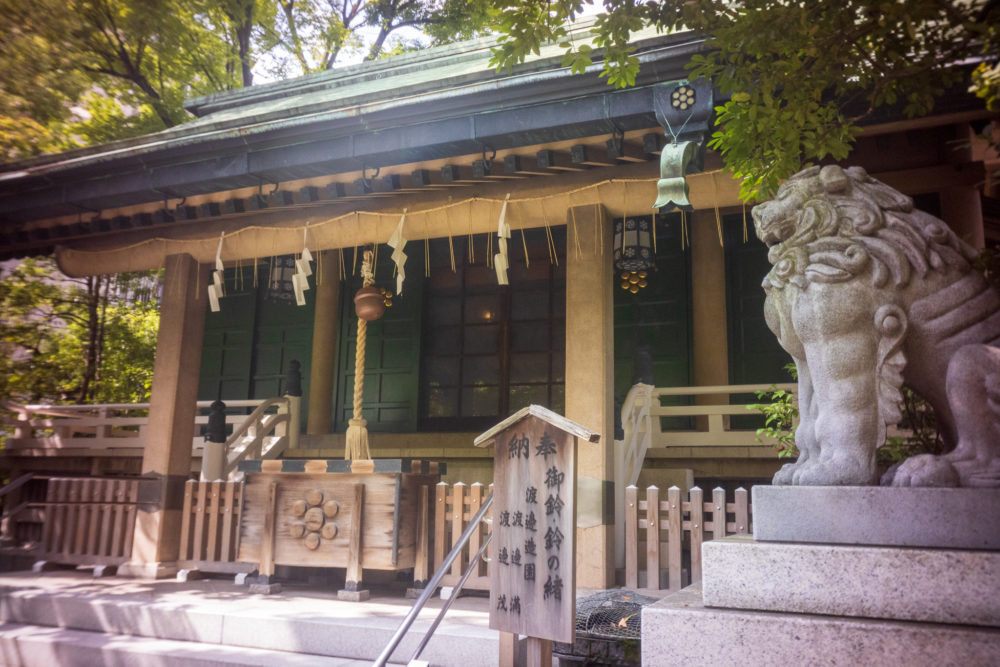Our “Tokyo Shitamachi Tour” category recommends where to visit for sightseeing in Tokyo’s Shitamachi area (the area along and east of the Sumida River). We select a different theme each time and propose a model course of casual self-guided tours.
If you plan to visit Tokyo, the Tokyo Shitamachi Tour is exactly for you. It will help you to find where to go in the Shitamachi area of Tokyo.
This time, we chose Asakura Okura. Asakura Okura is the biggest rice storehouse that existed by the Sumida River during the Edo Period. Kuramae, the neighborhood of Asakusa, is named for Asakusa Okura.
This article will cover various historical sites related to Asakusa Okura. For your self-guided tour, you can visit all of them, or you can pick some of them. It’s all up to you!
We hope this blog post will help you somewhat when you visit Tokyo for sightseeing. If you have any questions, feel free to contact us through the contact form.
This blog post is also available in Japanese. You can refer to it at the following link:
- Tour Overview
- Tour Details
- Route Details
- Asakusa Station on the Tobu Isesaki Line (AKA. the Tobu Skytree Line)
- The Azumabashi Bridge
- Sumida River Terrace
- The Umayabashi Bridge
- The Kuramaebashi Bridge
- The Exhibits of Ukiyo-e
- Noname Stairs
- Dairokuten Sakaki Shrine
- Yanagibashi-Bunin-Iriguchi Stop of Megurin Bus
- Asakusa-Kikusui-Dori Stop of Megurin Bus
- Tawaramachi Station on the Ginza Line
- Route Details
Tour Overview

This tour features Asakusa Okura, the biggest rice storehouse that existed by the Sumida River from the 16th century to the early 20th century. We will visit many historical sites related to Asakusa Okura through the tour.
This tour is ideal if any of the following hits you:
- I want to visit sites other than Sensoji Temple in the Asakusa area;
- I want to walk along the Sumida River;
- I want to appreciate Ukiyo-e prints about Asakusa and Kuramae;
- I love horses;
- I want to visit the Buddha of animal protections;
- I want to visit the Shinto gods of beauty;
- etc.
Duration
- Duration: Appoximately 1 hour
Departure & Return
- Departure point: Asakusa Station on the Tobu Isesaki Line (AKA. the Tobu Skytree Line)
- Return point: Tawaramachi Station on the Ginza Line
Itinerary
We will visit four bridges over the Sumida River this time. But, the distance between the bridges on the Sumida River is small, so you do not have to worry that much.
- Asakusa Station on the Tobu Isesaki Line (AKA. the Tobu Skytree Line)
- The Azumabashi Bridge
- Sumida River Terrace
- The Komagatabashi Bridge
- Komagatado Hall
- The Umayabashi Bridge
- The Kuramaebashi Bridge
- Dairokuten Sakaki Shrine
- Yanagibashi-Bunin-Iriguchi Stop of Megurin Bus
- Asakusa-Kikusui-Dori Stop of Megurin Bus
- Tawaramachi Station on the Ginza Line
Restrooms
- Asakusa Station on the Tobu Isesaki Line (AKA. the Tobu Skytree Line)
- The Azumabashi Bridge (behind the Tokyo Cruise Ship building)
- The Komagatabashi Bridge
- The Umayabashi Bridge
- Okuramae Park behind Dairokuten Sakaki Shrine
- Yanagibashi 2-Chome Police box near Dairokuten Sakaki Shrine
- Tawaramachi Police box near Asakusa Kikusui-Dori Stop of Megurin Bus
- etc.
Tour Details
Route Details
Asakusa Station on the Tobu Isesaki Line (AKA. the Tobu Skytree Line)

The depature point for this time is the Central Exit of Asakusa Station on the Tobu Isesaki Line (AKA. the Tobu Skytree Line.)
This exit is connected by an underground passage from Asakusa Station on the Ginza Line and Asakusa Line. So, you can also come to this exist by Ginza Line or Asakusa Line.
Go forward-left with Asakusa Station behind you to go to the Azumabashi Bridge, our next stop. Then cross the pedestrian crossing and pass by the police box. The Azumabashi Bridge is about a minute away from Asakusa Station on the Tobu Isesaki Line.
The Azumabashi Bridge

The Azumabashi Bridge is a bridge over the Sumida River that connects Taito Ward and Sumida Ward.
The Taito Ward side of this bridge is a good place to take pictures. Here, you can take pictures of Tokyo Skytree, the Headquarters Building of Asahi Breweries, and the gold flame sculpture, and more.
There is a water bus stop next to the Azumabashi Bridge. So you can take pictures of the water bus as well. Besides that, depending on the time of day, you can also take a picture of the houseboat together.
Sumida River Terrace
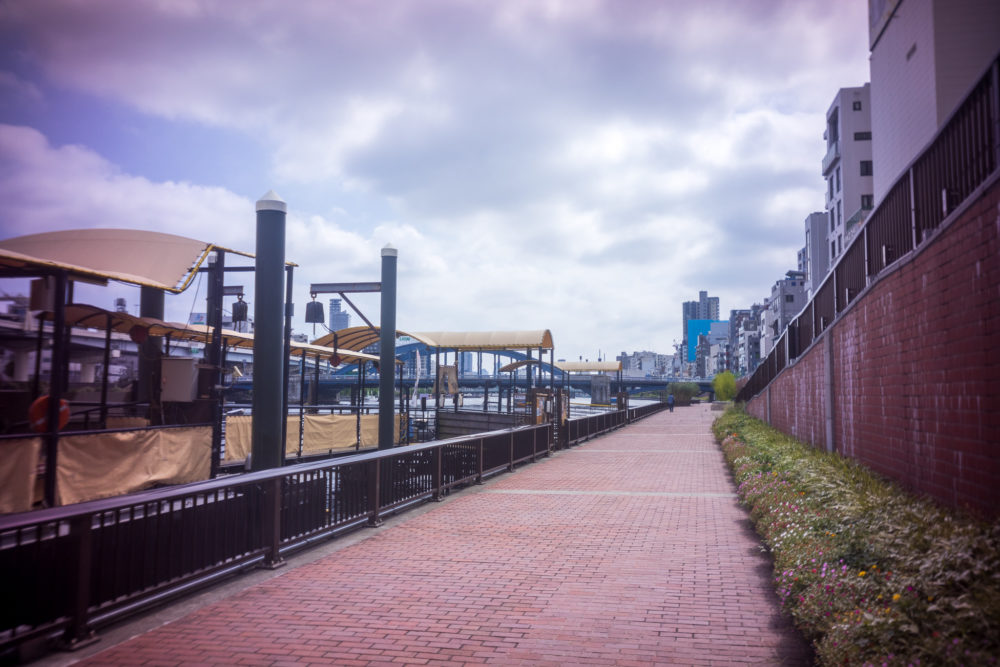
Take the stairs next to the Azumabashi Bridge down to Sumida River Terrace. Sumida River Terrace is a paved, flat, and pedestrian-only promenade; it’s easy to walk for everyone.
Tokyo Skytree

You can view Tokyo Skytree from Sumida River Terrace very clearly. As this promenade is not crowded most of the time, you can take it easy on taking pictures.
The Komagata Bridge
If you walk down Sumida River Terrace from the Azumabashi Bridge for about 5 minutes, you will get to the Komagatabashi Bridge. The Komagatabashi Bridge is named for Komagata Hall at the west end of this bridge.
You can find stairs at the Komagatabashi Bridge. Climb up the stairs to the ground level. Komagata Hall and public restrooms are there.
Komagata Hall

Komagatado Hall is one of the Buddhist halls of Sensoji Temple. They claim this place “the birthplace of Sensoji Temple.”
The history of Sensoji Temple began when two fisherman brothers picked up a statue of Kannon in the Sumida River. Sensoji Temple says the brothers found the statue near Komagatado Hall.
Komagatado Hall enshrined Bato-Kannon, the horse-headed Kannon. The divine virtues of this Kannon are animal protection (especially horses), travel safety, good health, etc.
Near Komagatado Hall, there were stables for the horses that carried the rice of Asakusa Okura. This may be why the principal image of this hall is Bato-Kannon.
For more information about Sensoji Temple, please refer to the following blog post:
The Monument of Komagatabashi Bridge and Mihashira
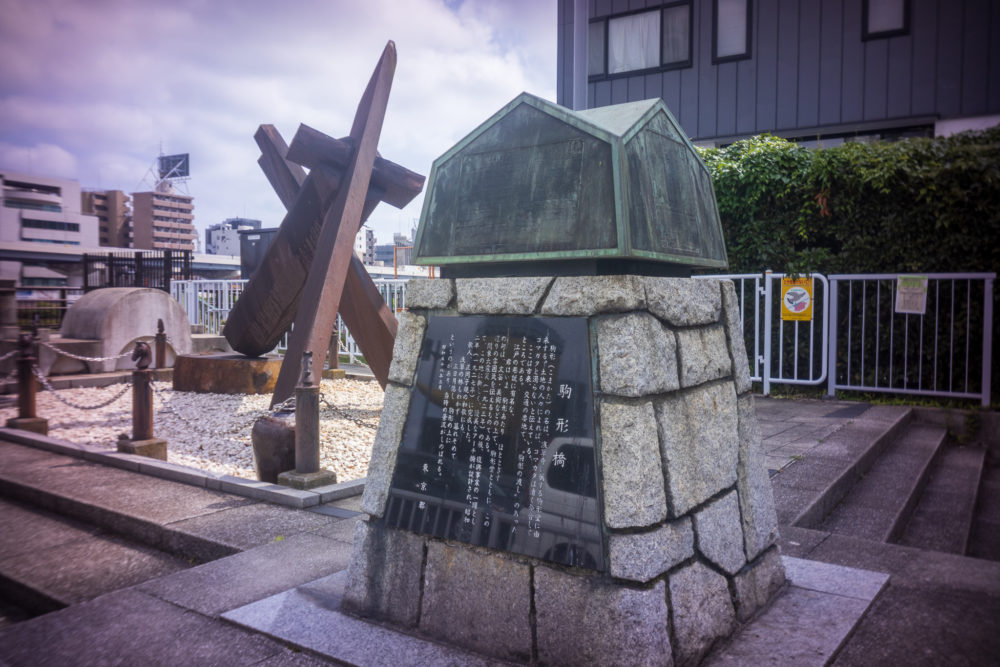
On the opposite side of Asakusa-Dori Avenue from Komagatado Hall, there is a monument of the Komagatabashi Bridge. This monument explains the history of the bridge.
Next to the monument of the Komagatabashi Bridge, there is a work of art called “Mihashira.” Its description says “Tokyo Metropolitan Cultural Design Project 1987.”
It could be hard to see in the photo above, but the poles that connect the chain have a horse on the top.
The Umayabashi Bridge
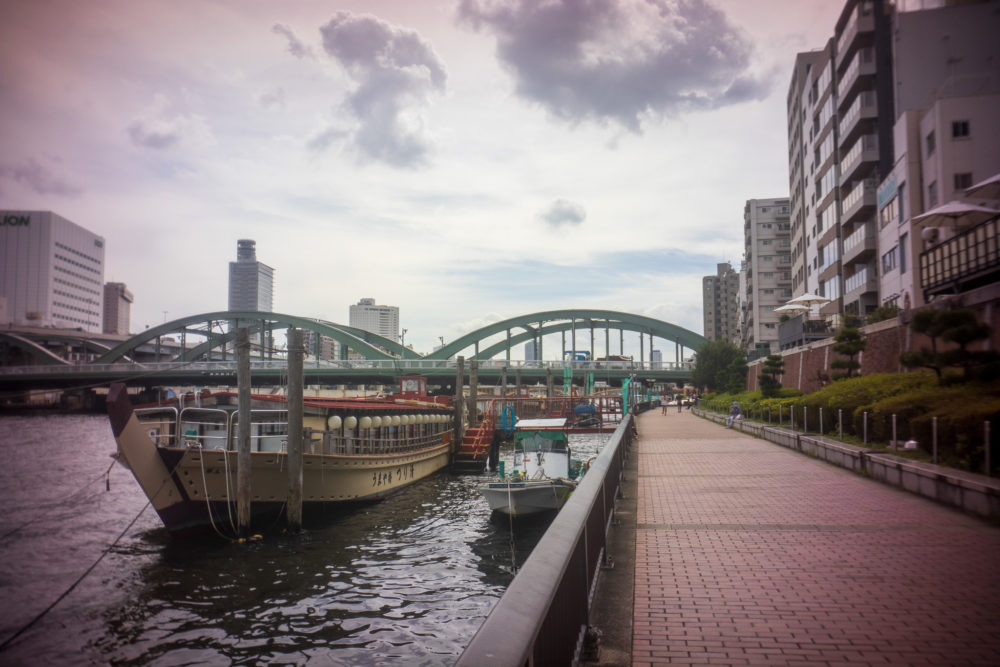
Let’s walk on Sumida River Terrace from the Komagatabashi Bridge to the Umayabashi Bridge. It should take about 3 minutes on foot.
The name Umayabashi is named from Umaya (stables in English). There were stables in this neighborhood for the horses that carried the rice of Asakusa Okura.
The Public Restroom at the Umayabashi Bridge
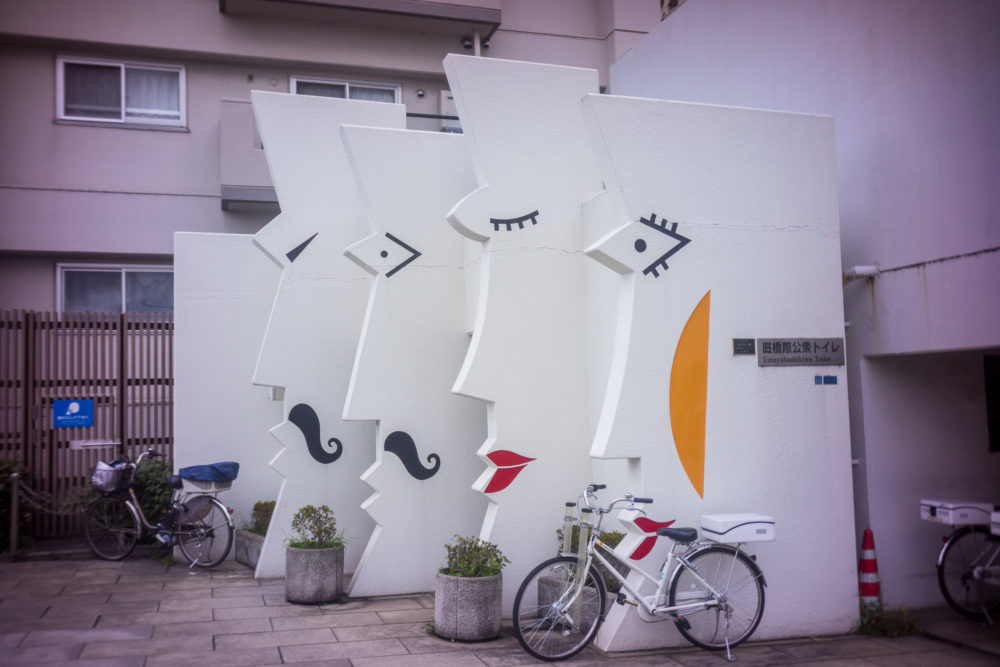
At the west end of Umayabashi, there is a public restroom with an interesting design. Four faces are designed. This public restroom won the “Taito Street Landscape Contest” in 1992.
Street Lights at the Umayabashi Bridge

The Umayabashi Bridge features horses in many things. It could be fun to look for horses when you visit this bridge.
The Kuramaebashi Bridge
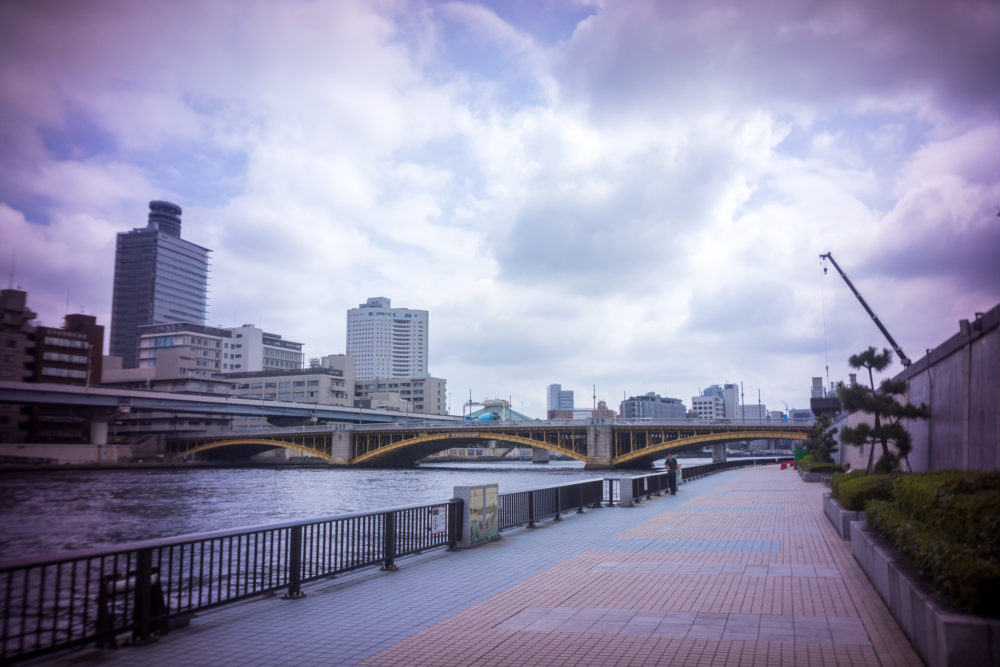
Let’s walk on Sumida River Terrace from the Umayabashi Bridge to the Kuramaebashi Bridge. It should take about 3 minutes on foot. According to a map in the 18th century, Asakusa Okura was around here.
The Exhibits of Ukiyo-e
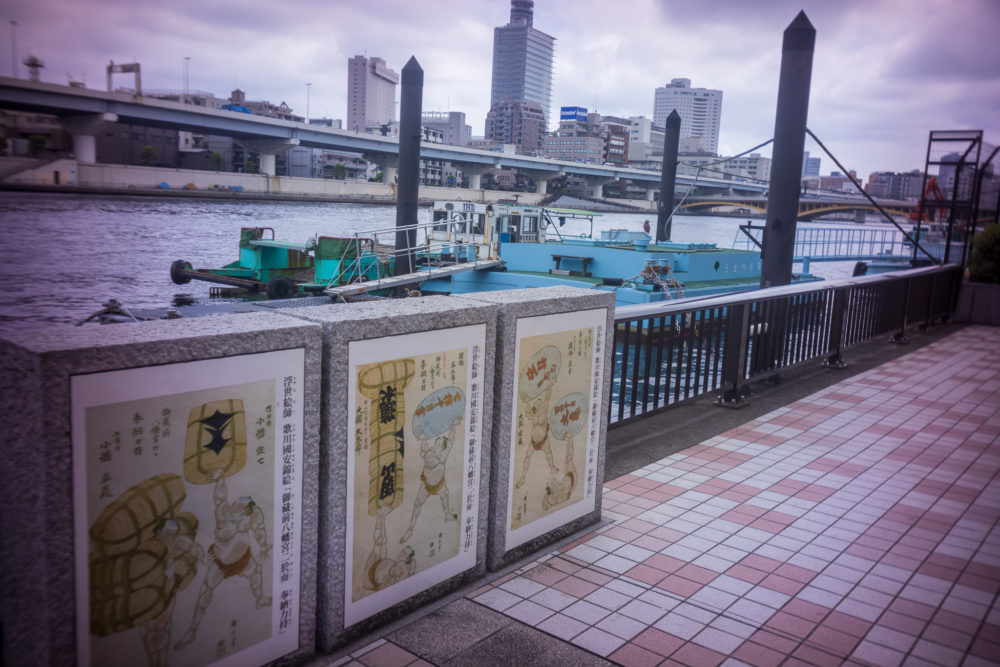
After passing the Umayabashi Bridge, there are exhibits here and there with the ukiyo-e motifs of KATSUSHIKA Hokusai and UTAGAWA Hiroshige.
These ukiyo-e prints depict people who lived in this neighborhood during the Edo period. You can learn about the culture and lifestyle of the time.
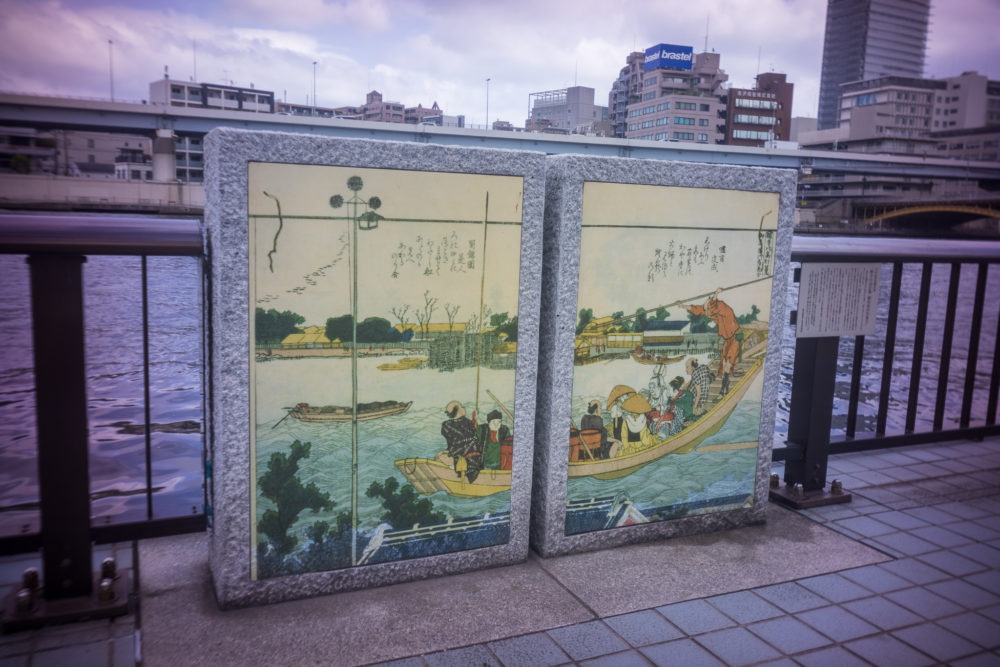
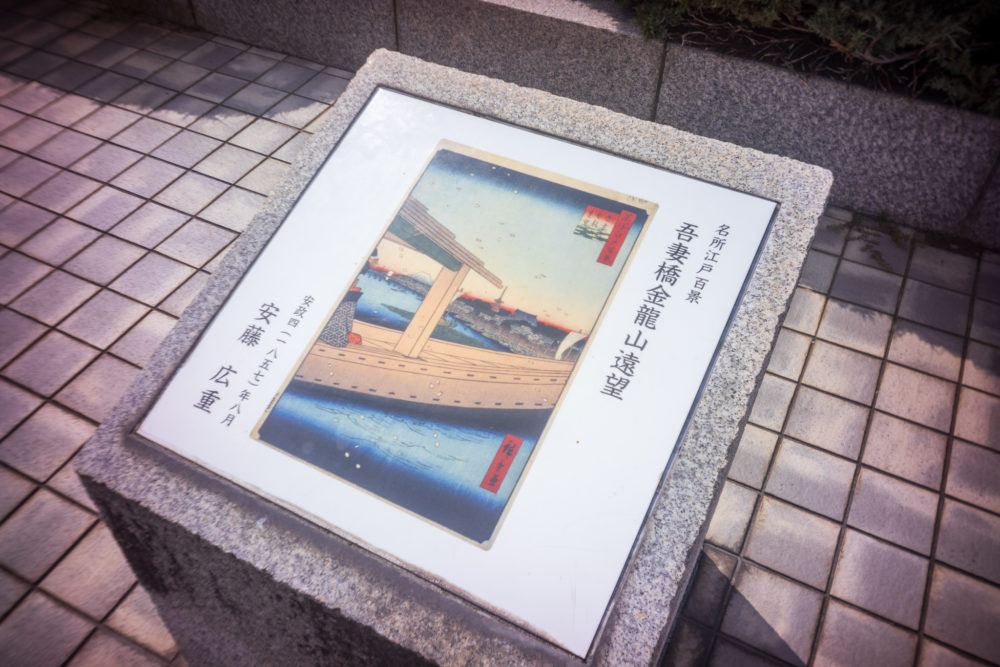
The Stone Monument of Asakusa Okura
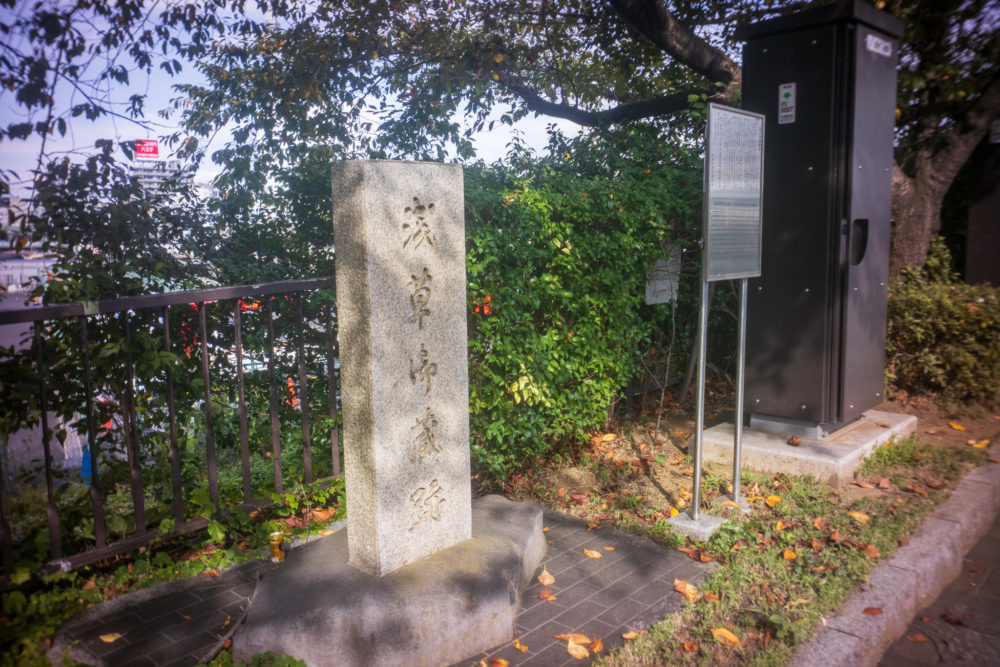
At the west end of the Kuramaebashi Bridge, there is a stone monument of Asakusa Okura. Its description says that Asakusa Okura was in this area.
The Stone Monument of Shubi-no-Matsu (The Pine Tree of Success)
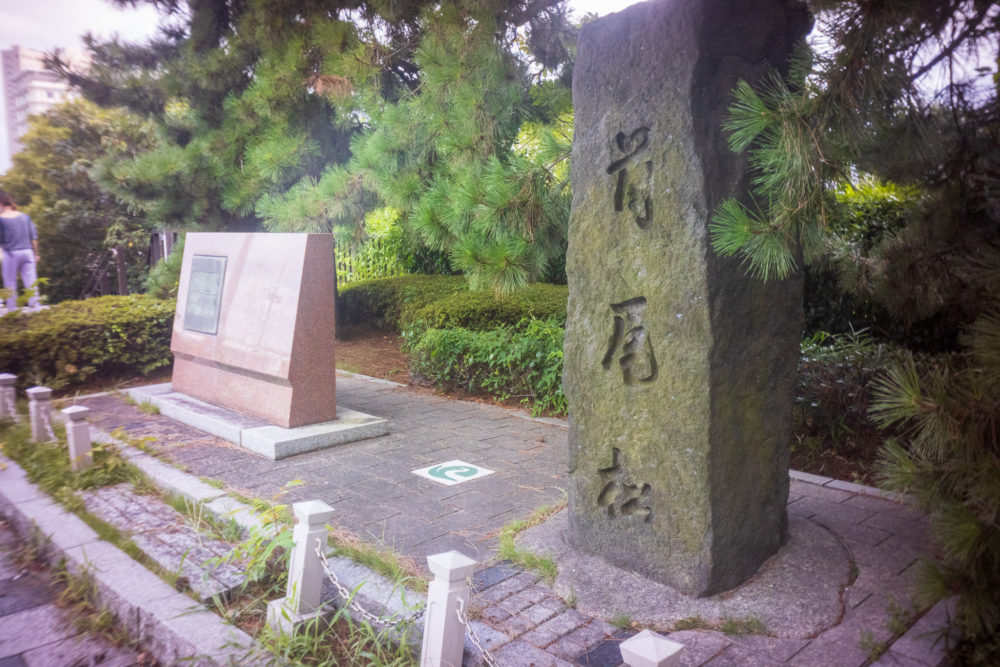
Across the road from the stone monument of Asakusa Okura, there is another one. This is the monument of Shubi-no-Matsu (the pine tree of success.)
Shubi-no-Matsu was a pine tree planted along the Sumida River in the center of Asakusa Okura. According to the description board, its exact location was about 100 meters downstream from the Kuramaebashi Bridge.

There are several possible origins of the name of Shubi-no-Matsu. One of them is related to Shin-Yoshiwara, the biggest legal red-light district which existed until 1957 near Asakusa.
In the Edo Period, when people went to Shin-Yoshiwara, they used boats to travel along the Sumida River and Sanyabori Waterway. At the time, taking a boat was a stylish way to visit Shin-Yoshiwara.
On the way from Shin-Yoshiwara, people stopped their boat around the pine tree, then talked about their success at Shin-Yoshiwara each other. That’s what we heard.
For more information about Shin-Yoshiwara, please refer to the following blog post:
Noname Stairs
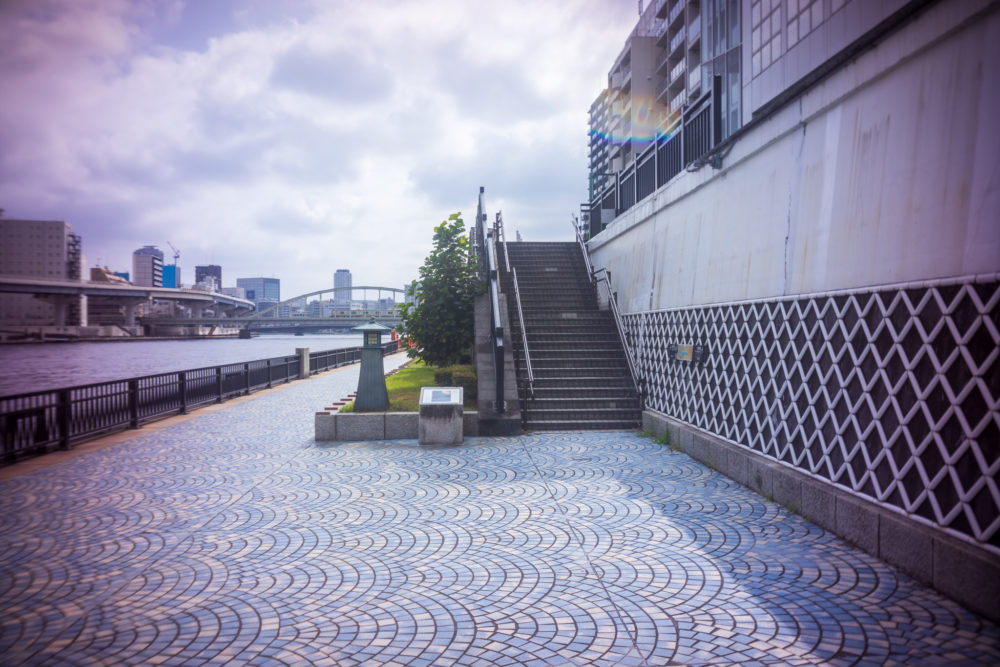
If you walk down Sumida River Terrace from the Kuramaebashi Bridge a bit more, you will find stairs. Climbing the stairs is the quickest way to Dairokuten Sakaki Shrine.
For reference, you can see the yellow and green roof of Ryogoku Kokugikan Hall, the Sumo Arena, on the other side of the Sumida River from here. It is possible to walk from Asakusa to Ryogoku or vice versa.
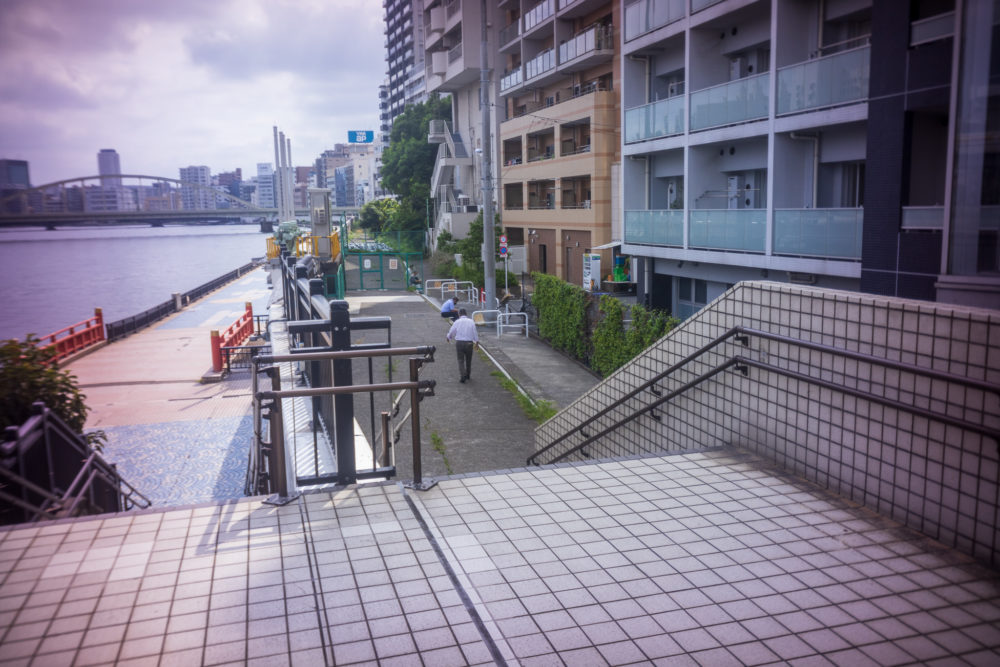
After climbing the stairs, walk straight ahead. Then turn right at the end. If you keep walking for about 3 minutes or so, you will get to Dairokuten Sakaki Shrine.
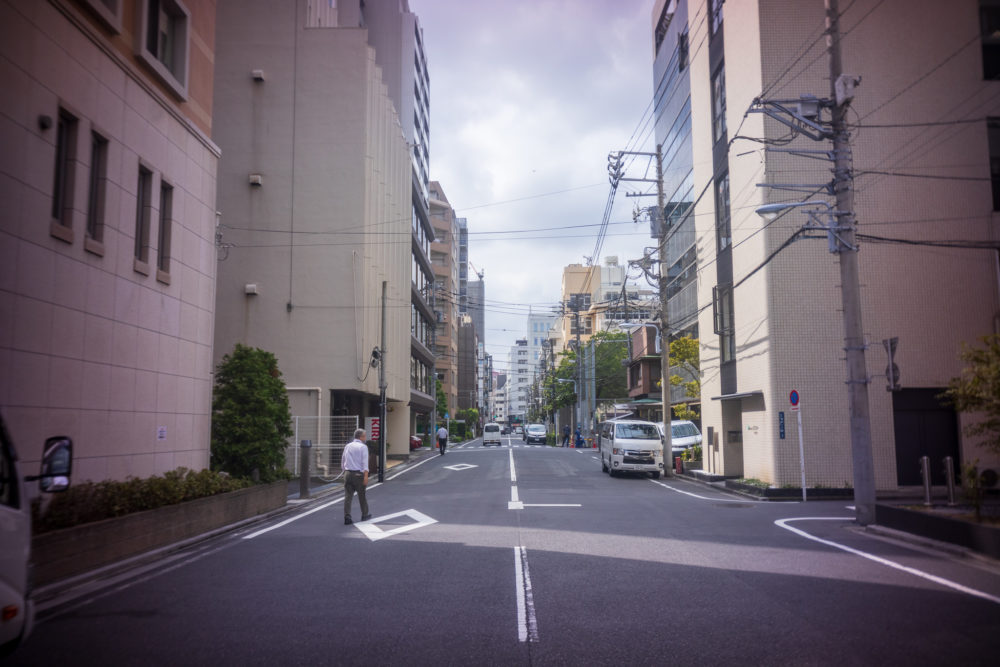
Dairokuten Sakaki Shrine
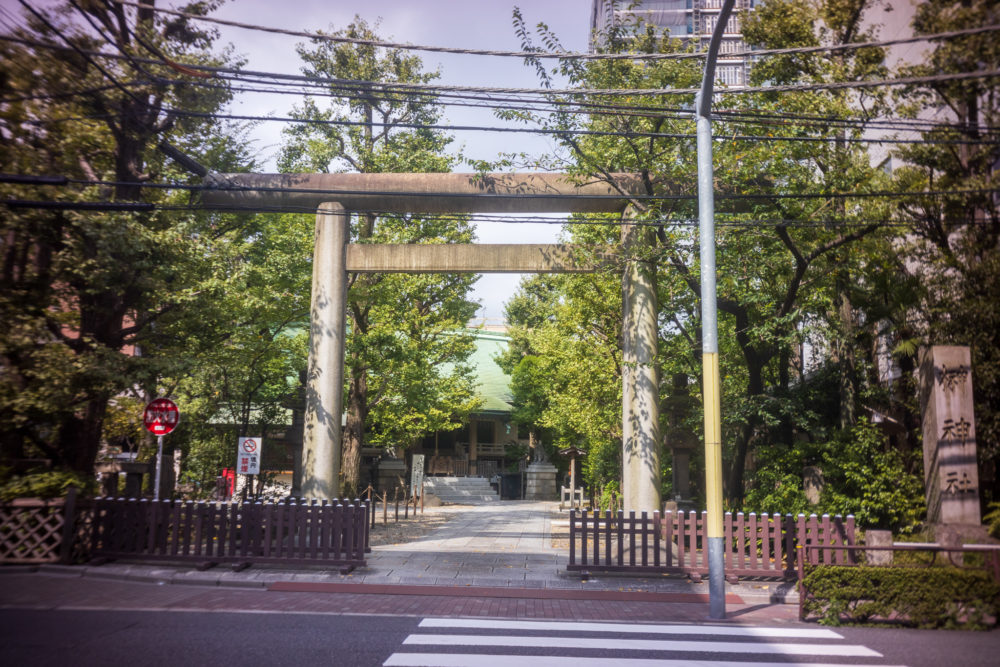
Dairokuten Sakaki Shrine is a very old Shinto shrine with a history of over 1,900 years. During the Edo period, this shrine was regarded as the guardian of Asakusa Okura. Therefore, the Tokugawa Shogunate treasured this shrine very much.
This Shinto shrine enshrines Omodaru-no-Mikoto and Kashikone-no-Mikoto. These two pillars of gods are extremely beautiful. People in the olden days thought that if they prayed for these gods, they would also become beautiful.
Yanagibashi-Bunin-Iriguchi Stop of Megurin Bus
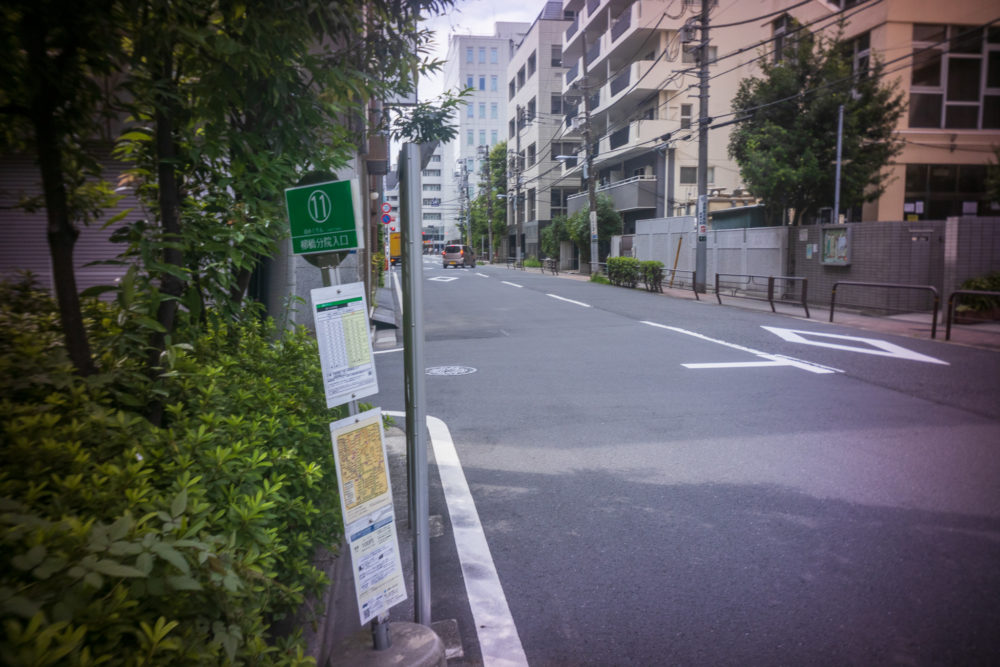
After visiting Dairokuten Sakaki Shrine, let’s take Megurin Bus to Asakusa. The nearest stop is Yanagibashi-Bunin-Iriguchi Stop (Stop #11) on Megurin South Route.
This stop is on the way from Sumida River Terrace to Dairokuten Sakaki Shrine. You will find it near the gate of Asakusa Jr. High School (on the other side of the street.)
Asakusa-Kikusui-Dori Stop of Megurin Bus
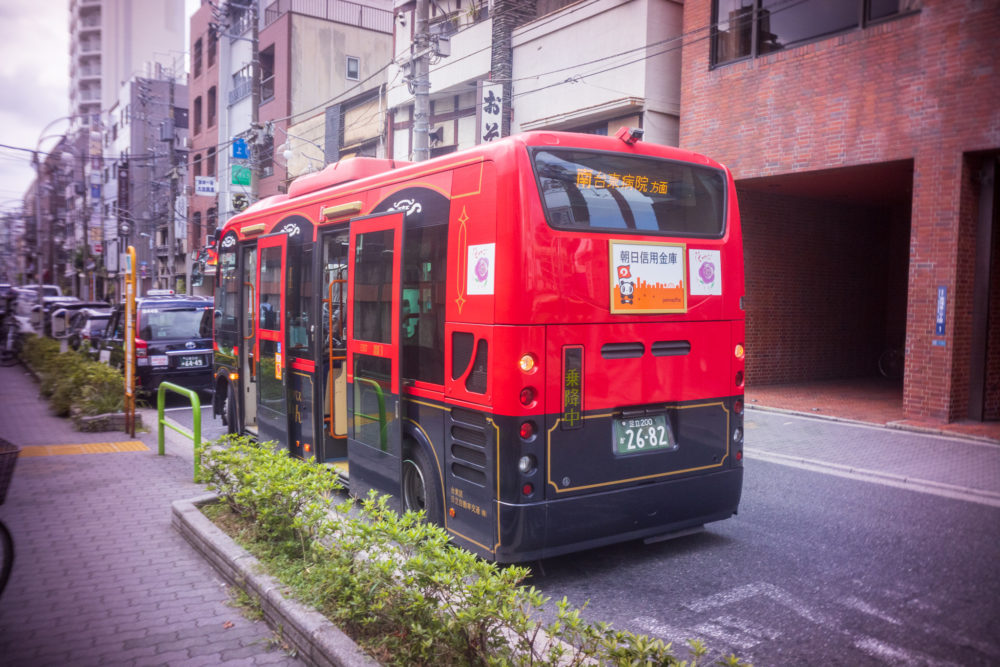
This time, get off Megurin Bus at Asakusa-Kikusui-Dori Stop (Stop #18.) It takes about 15 minutes from Yanagibashi-Bunin-Iriguchi Stop.
You can walk to the following stations from this bus stop:
- Tawaramachi Station on the Ginza Line (2 minutes)
- Asakusa Station on the Ginza Line (7 minutes)
- Asakusa Station on the Asakusa Line (7 minutes)
- Asakusa Station on the Tobu Isesaki Line (10 minutes)
- Asakusa Station on the Tsukuba Express Line (5 minutes)
The time mentioned here is just a rough estimate. If the streets are crowded, it may take longer.
Tawaramachi Station on the Ginza Line
For the time being, we chose Tawaramachi Station as the return point of this tour. If your time allows, you may also want to visit Kappabashi Kitchenware Town and/or Sensoji Temple from here.
Foro more information on how to get to Kappabashi Kitchenware Town from Tawaramachi Station, please refer to the following blog post:
